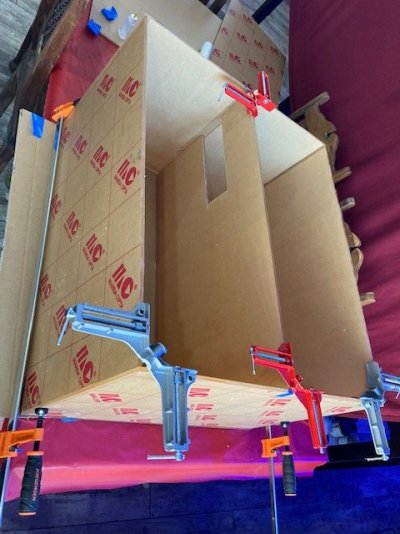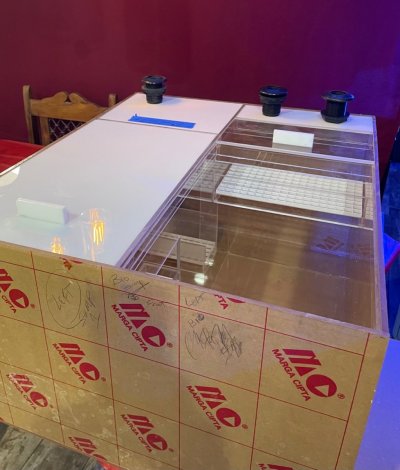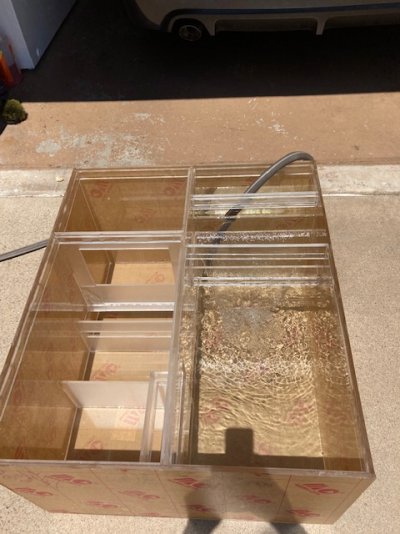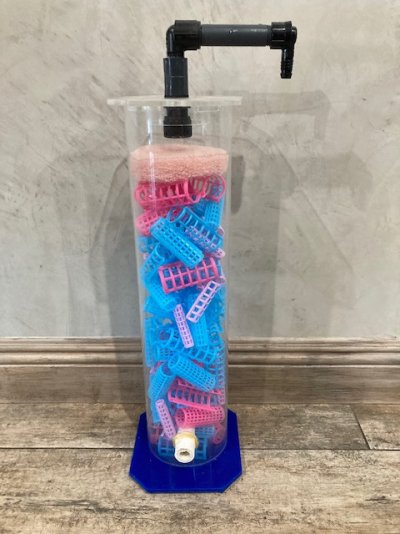Actually in the 80's and early 90's we used bio bale. Bio Balls did not come around until middle 90's(at least in San Antonio). By then rock and roll was dead, and except for a few country singers like George Strait, country was sliding fast also. And don't get me started on what country rap junk they are playing on the radio todayAs I recall the term nitrate factory did not refer to the bio- balls “creating” nitrate. Like most things left unattended they become detritus traps. We found that replacing a small portion every so often mitigated this. They were as one said part of the “trickle”. Any filter media I think has its place, we just need to understand how to manage and take care of it. And if you use actual bio-balls, you will be required to listen to 80’s music from time to time....
Navigation
Install the app
How to install the app on iOS
Follow along with the video below to see how to install our site as a web app on your home screen.
Note: This feature may not be available in some browsers.
More options
You are using an out of date browser. It may not display this or other websites correctly.
You should upgrade or use an alternative browser.
You should upgrade or use an alternative browser.
Bio balls...a thing of the past?
- Thread starter KellyCorals
- Start date
- Tagged users None
Actually changed my sump set up around again since I last posed pictures. Ditched my “no name” skimmer and went with an eshopps S-120 that seems to chop up the bubbles much finer almost looks like milk in the skimmer tube. Changed my led light that I robbed from one of my kids old freshwater tanks and had shining thru the side of the sump to an eshopps fuge light ( really bright for only 3 LEDs ) that mounts to the top of the sump and went ahead and bought some more chetto algae from the LFS AND added on a aquatop 36 watt UV Sterilizer! What more filtration could this tank need?!? As you can maybe see in the pictures I’m having a Dino outbreak right now...happened 2 weeks after running flux RX to get rid of the hair algae ( which it did a great job) but starting to feel like I traded one evil algae for another!



- Joined
- Jul 14, 2019
- Messages
- 177
- Reaction score
- 57
So I’m in the same boat and have bio balls in a trickle system and I do not have a skimmer. Can I still take out my bio balls slowly and maybe replace with some rock to keep the noise down?So after reading what everyone had to say about it I’m thinking about removing the bio balls entirely and leaving my maxspect spheres and blocks in the sump but fully submerged. Also highly considering changing sump because it is a “wet/dry” set up. Just hoping this change won’t shock the system to much so I’m going to try and take the bio balls out a little at a time.
I would strongly advise the opposite. You will change your whole systems nitrification behavior if you do that - I explain why in this thread
Sincerely Lasse
Sincerely Lasse
- Joined
- Jul 14, 2019
- Messages
- 177
- Reaction score
- 57
Well I wasn’t sure because I have about 50lbs of live rock in my 65gal tank established as wellI would strongly advise the opposite. You will change your whole systems nitrification behavior if you do that - I explain why in this thread
Sincerely Lasse
which seems more impactful, removing four hundred reefs sandbeds all at once, or just some bioballs while the sand remains?

 www.reef2reef.com
www.reef2reef.com
Ray your inclinations were correct
if you entered that thread, we can remove your sand, the extra bioballs, and probably a third of your live rock and whats left would handle nitrification exactly the same as when it was packed with extras.
if you plumb in two canister filters to any reef, you are allowed to remove them at any time later, because they didn’t rob bacteria from the display, they’re extras, expendable.
kicking up a bunch of waste off the bioballs is the real risk, detritus is what kills- never lack of bacteria. Nobody’s reef tank runs low on surface area.

Official Sand Rinse and Tank Transfer thread
I am fairly worried about moving my freshwater setup as it is fairly overstocked (reduces aggression as no one fish gets singled out). I did fail to think about the toxicity of nitrite on top of ammonia toxicity... Here is my plan for the cichlid tank. I have gradually reduced my pH from 8.2 to...
 www.reef2reef.com
www.reef2reef.com
Ray your inclinations were correct
if you entered that thread, we can remove your sand, the extra bioballs, and probably a third of your live rock and whats left would handle nitrification exactly the same as when it was packed with extras.
if you plumb in two canister filters to any reef, you are allowed to remove them at any time later, because they didn’t rob bacteria from the display, they’re extras, expendable.
kicking up a bunch of waste off the bioballs is the real risk, detritus is what kills- never lack of bacteria. Nobody’s reef tank runs low on surface area.
Last edited:
I changed my sump out when I got a new aquarium. Both were 200 gallon. I went from a wet/dry with bioballs to a regular sump. I had no choice as the wet/dry would not fit. I did keep the rock, but none of the crushed coral bed.Well I wasn’t sure because I have about 50lbs of live rock in my 65gal tank established as well
I bought 2 - 4x4x8 blocks of Marinepure 2 months ahead of time and submerged them in the old sump. When the change was made I just moved them into the new sump. I had no problem with nitrification at all. One block is supposed to be good enough for a 250 gallon tank. So I figured two would get me through the change and they did.
Some people talk about bacteria as on organism with the same demands. Some people says bacteria will grow everywhere on a surface. Some people does not differ between autotrophic and heterotrophic bacteria when they give advises. Some people does not say that the nitrification bacteria will easily be competited out of heterotrophic bacteria if not organic load will be flushed away.
Some people says that "detritus" (without any description of what it is) crash tanks when the right description is that heterotrophic breakdown bacteria dominate the surfaces and either compete out the nitrification bacteria or/and create oxygen free environment that after denitrification cause forming of hydrogen sulphide.
The result will be a whipped out tank by free ammonia or free hydrogen sulphide (or sometimes both)
A right constructed biofilter (as in my thread I linked to) will not build up any films of heterotrophic bacteria and optimize the nitrification. It means no need of sand cleaning threads for normal aquariums (I´m not talking about vases and pico aquariums here - I´m talking about normal aquariums)
How long time have you run that setup. IMO a a submerged bio-block will not add much to the nitrification (the oxygen will be too low in the the inner parts of the block) However - it can be a part of the denitrification after a while.
Sincerely Lasse
Some people says that "detritus" (without any description of what it is) crash tanks when the right description is that heterotrophic breakdown bacteria dominate the surfaces and either compete out the nitrification bacteria or/and create oxygen free environment that after denitrification cause forming of hydrogen sulphide.
The result will be a whipped out tank by free ammonia or free hydrogen sulphide (or sometimes both)
A right constructed biofilter (as in my thread I linked to) will not build up any films of heterotrophic bacteria and optimize the nitrification. It means no need of sand cleaning threads for normal aquariums (I´m not talking about vases and pico aquariums here - I´m talking about normal aquariums)
I had no problem with nitrification at all. One block is supposed to be good enough for a 250 gallon tank. So I figured two would get me through the change and they did.
How long time have you run that setup. IMO a a submerged bio-block will not add much to the nitrification (the oxygen will be too low in the the inner parts of the block) However - it can be a part of the denitrification after a while.
Sincerely Lasse
Last edited:
In a vase or pico aquarium - you can´t use the same tools as you do in a normal aquarium - I understand that. In that case - sand cleaning can be a tool. In these aquariums - not much fish (if any) - no direct ammonium release. But it does not mean that sand cleaning is the way to handle a larger aquarium with more (and larger fish). There is other ways - proven right since decades. A proper constructed biofilter is one of these tools.
Sincerely Lasse
Sincerely Lasse
So I was able to remove half of my bio balls at a time and replace the bio ball set up with a hang on filter sock attachment made by eshopps - which I thought was a great upgrade. Then I found out if I lightly pack the filter sock with poly fill (aquarium approved) it really quieted down the sump drain almost entirely. I then later put a piece of live rock in the sump with some mushrooms growing on in and added a fuge light made by eshopps and some cheato algae and now have a fuge. The mushrooms actually are doing great and love living in the sump under the led fuge light.So I’m in the same boat and have bio balls in a trickle system and I do not have a skimmer. Can I still take out my bio balls slowly and maybe replace with some rock to keep the noise down?
- Joined
- Jan 22, 2019
- Messages
- 446
- Reaction score
- 968
Why are there not giant bioballs with guaranteed room for anaerobic bacteria?
I run as many thick boulder rocks in the tank as possible for this reason alone - would buy a giant 12"x12" biocube if it guaranteed more anearobics that the same cubic foot of live rock.
I run as many thick boulder rocks in the tank as possible for this reason alone - would buy a giant 12"x12" biocube if it guaranteed more anearobics that the same cubic foot of live rock.
Here is what my sump is looking like these days...much happier with this over a bunch of bio balls
But - the two different methods solve different problems - the result in water values can be the same (but does not need to). I prefer to use both methods.
Here is what my sump is looking like these days...much happier with this over a bunch of bio balls
Sincerely Lasse
- Joined
- Jul 14, 2019
- Messages
- 177
- Reaction score
- 57
That’s pretty cool man I like that. I’m actually going to build a custom diy sump. Petco has the $1 gallon tank deal going right now so I just picked up a 20gal long tank. Now looking for either plexiglass or glass pieces. I guess ace hardware cuts them to size
Here is what my sump is looking like these days...much happier with this over a bunch of bio balls
Look on eBay for pre made sump inserts that you silicone into place. I’m buying a kit from there for a 10 gallon that even holds a filter sock.That’s pretty cool man I like that. I’m actually going to build a custom diy sump. Petco has the $1 gallon tank deal going right now so I just picked up a 20gal long tank. Now looking for either plexiglass or glass pieces. I guess ace hardware cuts them to size
First note the 300 gallon I am building is bare bottom, except for 1/5 of it has 10 pounds of aragonite sand for a wrasse. Since I have bio balls in chamber 3 of my two sumps on my 300, along with 10 pounds of aragonite rubble in chamber two of both sumps, I want to add a way to add more air/water contact so, thinking back to the 80/90s of those wet/dry filters we all used. I made this air/exchange tower using plastic hair rollers to give me more break up of water and less future problems of plastic bio balls getting clogged.I´m not sure of that.
What exactly are benthic heterotrophs doing in a food web and what´s their growth limitation in a normal aquarium? What type of heterotrophs dominate in an aquarium (benthic or pelagic). What type of heterotrophs will eventually be skimmed out - benthic or pelagic? (I´m aware of benthic bacteria attached to particles in the water - but in general) What´s timescale of the mineralization process in an aquarium without adding of external DOC compared with an aquarium there external DOC will be added? What´s the timescale for growth of nitrification (they are benthic and build biofilms) bacteria compared with benthic heterotrophs.
How will anaerobic heterotrophs use DOC (mainly as a growth factor or as an alternative electron donor in the metabolism) ? What will anaerobic breakdown process produce as waste?
What´s the output of NH3/NH4 from added food in an aquarium?
There is a lot of more questions to be put - but all indicate that use of external DOC will release more NH3/NH4 into the water column during the same timescale compared with an aquarium without external DOC addition if the input of organic N is the same in both systems (input of organic N - other words for input of food). The answers will also indicate that use of optimized nitrification filters will be more and more important with rising external DOC addition. The surface available for growth of bacteria film needs to be huge in order to support both autotrophs and heterotrophs. The nitrification bacteria is extremely oxygen dependent and can only be active in the first µm of the the interference zone between water and substrate. Because of this - the use of substrate with "huge" internal space is worthless for the nitrification process - biofilm of heterotrophs will rapidly block all of this "huge amount" of pores. However - they can be excellent for passive denitrification - they work like a DSB.
A good nitrification filter should have a good flow, much surface that is in contact with the high flow, hence most of the dead biofilm (dead for nitrification purpose) will be flushed away (good for your corals and filtrating animals). High flow also mean that more oxygen will be transported into the biofilm per time period - important in saltwater because of the fact that saltwater at the same temperature will carry 1,5 mg lesser O2 per L compared with freshwater. Bioballs is one good filtration media for nitrification. Many other filters is good too - like foam filters - but for all of them is very important with a high flow - it means high oxygen supply and that "dead" (maybe oxygen depleted is a better word because the film is in reality heterotrophic bacteria using low amount or no oxygen in their metabolism) biofilm is flushed away.
The general idea about zeolite filters is that they are good because they block ammonium that will be used of nitrification bacteria with time. There is one incorrectness with that statement - many studies of nitrification bacteria have shown that they can only use NH3/NH4 in solution - not blocked NH3/NH4. Its also unclear if zeolite really is able to block ammonia in saltwater because of the high chloride concentration. However - do zeolite filter works as nitrification filters. IMO - if they are used as intended - with backflush one to twice each day - they work as an charm as nitrification filters. The backflush just throw away dead biofilm (high in heterotrophs) and enables nitrifiers to grow without competition.
But if you do not want to backflush your filter twice a day? Because that oxygen is a critical factor - high flow filters that's not is drowned - as trickle filters with an air space between water level and the lower part of the filter (it will allow an reversed airstream going up) are an alternative. Because of the high flow they will backflush in a continuous way. But there is a myth that the water should be at a low flow rate and rise the contact period - this is not valid for a recirculated system like an aquarium - on the contrary - as high flow as possible is better both to allow high oxygen levels and to maintain a thin active biofilm of nitrifiers.
I´m talking about to optimize the process not about that mixed biofilms ( like the ones @Belgian Anthias advocate for) will work or not (they will work in low loaded systems) but need a huge space. IMO - it is better to have two different types of "biofiltering spots" - each optimized for its own purpose.
A word about "high" concentration of nitrate and its negative impact on corals and other invertebrates - has this really been shown in controlled experiments as a lonely factor? I have read much about this but really not seen any "hard" facts about it.
Sincerely Lasse
It will have a small pump feeding it water slowly which will then flow out the bottom pipe into the sump.
Note for $14.00 on amazon I got these rollers which added up to 2 gallons of area. They are different sizes.
Time will tell if my idea works.
Attachments
Nice!! I am very interested to see how it works! What did you use for the tower and base?First note the 300 gallon I am building is bare bottom, except for 1/5 of it has 10 pounds of aragonite sand for a wrasse. Since I have bio balls in chamber 3 of my two sumps on my 300, along with 10 pounds of aragonite rubble in chamber two of both sumps, I want to add a way to add more air/water contact so, thinking back to the 80/90s of those wet/dry filters we all used. I made this air/exchange tower using plastic hair rollers to give me more break up of water and less future problems of plastic bio balls getting clogged.
It will have a small pump feeding it water slowly which will then flow out the bottom pipe into the sump.
Note for $14.00 on amazon I got these rollers which added up to 2 gallons of area. They are different sizes.
Time will tell if my idea works.
I make little "Crates" to hold ceramic rings and put them in my sump. Use the plastic diffusers and zip tie them together. Gives lots of space for critters to hide and breed as well.
Last edited:
acrylic extruded tubes and colored acrylic sheets. I have been cutting,gluing and making all I can to save cash. Even made two sumps.Nice!! I am very interested to see how it works! What did you use for the tower and base?
They are 24x28x15 high, race track design. one sump intake is on right and the other intake on left.
Check out my build thread to see more...
Thanks



Last edited:
Similar threads
-
- Question
- Replies
- 2
- Views
- 79
- Replies
- 1
- Views
- 57
- Replies
- 4
- Views
- 210


















